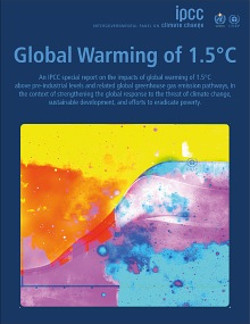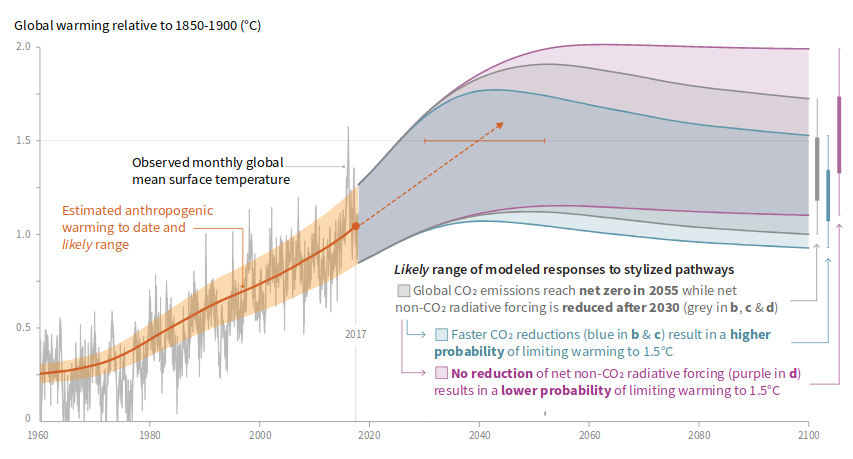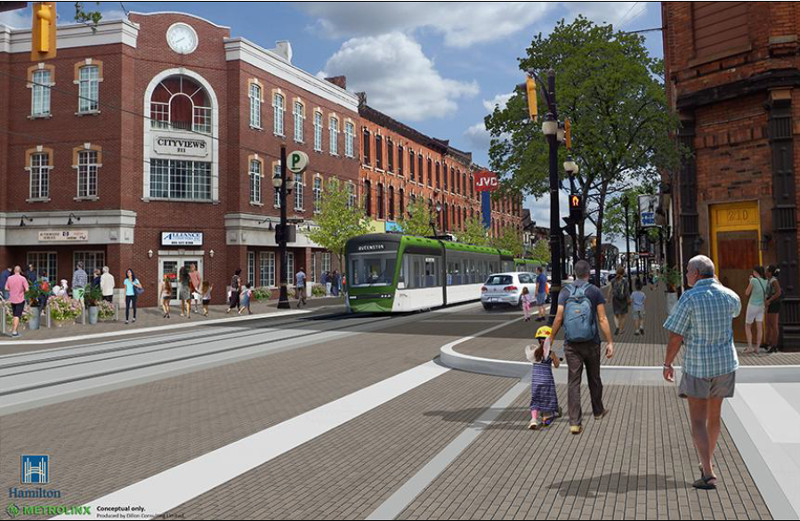The latest IPCC Report shows that cities and the policies they pursue have an important role to play in addressing the crisis. We need to bear this in mind in Hamilton as we prepare to vote for new leadership on City Council.
By John Loukidelis
Published October 15, 2018

The latest report from the Intergovernmental Panel on Climate Change (the Report) was released on October 9, 2018. The Report is a reminder, if one was needed, that the climate crisis represents the single greatest policy challenge facing humanity today.
The Report shows (again) that the crisis is an imminent threat, which the world's nations must confront together. The Report also shows, however, that cities can and must play an important role in addressing the issue. Hamilton voters should consider this as they go to the polls on October 22.
Hamilton voters should also consider the critical role that LRT will play in helping the City and its citizens make the changes that will be essential to reducing CO2 emissions and adapting to a low-carbon future.
The Report policy maker summary [PDF] (the Summary), in clear and stark terms, sets out the seriousness of the climate crisis and the massive effort that will be needed, not to prevent damage - because it's already too late for that - but to anticipate catastrophe.

Chart: observed changes and modeled responses to emisssions reductions (Image Credit: IPCC)
The Summary provides a helpful overview of the massive amount of information and data underyling the Report's conclusions. A number of publications have provided helpful summaries of the Report and its release, some of which can be found here, here and here.
The Report shows that humanity, and the environment on which it depends, will suffer significant adverse consequences with just a 1.5°C increase in global mean surface temperatures. This increase will happen very soon (between 2030 and 2052) at current rates of warming. (Summary §A.1)
The adverse consequences of warming will be even worse if it reaches 2°C, a level that used to be thought "safe". These effects include greater biodeversity loss, hotter extremes in inhabited areas, the permanent loss of coral reefs, higher ocean acidity, higher sea-level rise, heavier precipation in some regions and droughts in others. (Summary §§B1–B4)
Canadians should pay particular attention to the risks posed to our land: the Report warns that "high-latitude tundra and boreal forests are particularly at risk of climate change-induced degradation and loss, with woody shrubs already encroaching into the tundra". (Summary §B3.3)
To keep to "only" 1.5°C of warming, we will need to reduce emissions from 2010 levels by 45 percent by 2030 (!) and then reach net-zero global anthropogenic CO2 emissions by 2050. (Summary §C1) To prevent further warming after that, we will likely need industrial-scale CO2 removal for sustained net negative global anthropogenic emissions. (Summary §A2.2 and §C3)
The scale of the crisis is enormous and mind-bending in its complexity. It obviously requires a global response. The claims of de facto climate deniers in this country, that Canada alone cannot prevent a global catastrophe, although self-serving and disingenous, are unfortunately true.
That said, the Report shows that cities and the policies they pursue have an important role to play in addressing the crisis. We need to bear this in mind in Hamilton as we prepare to vote for new leadership on City Council.
At §C2.4, the Summary states that:
[t]he urban and infrastructure system transition consistent with limiting global warming to 1.5°C with no or limited overshoot would imply, for example, changes in land and urban planning practices, as well as deeper emissions reductions in transport and buildings compared to pathways that limit global warming below 2°C.
To reduce emissions, we must derive energy from sources other than fossil fuels, much sooner rather than later. Meeting demand without fossil fuels will be difficult or impossible, however, without also reducing that demand, especially in the building and transport sectors. (Report 2.5) "Buildings were responsible for 23 percent of global energy-related CO2 emissions, with one-third of those from direct fossil fuel consumption". (Report §2.4.3.2)
At the same time, "transport accounted for 28 percent of global final-energy demand and 23 percent of global energy-related CO2 emissions in 2014." (Report §2.4.3.3) In the transport sector, in particular, it will be impossible to meet targets for decarbonization without the electrification of transport and demand reduction. The latter entails avoiding trips, reducing the length of trips and shifting how trips are made. (Report §2.4.3.3)
What does this means for cities?
The long-lived urban transport, water and energy systems that will be constructed in the next three decades to support urban populations in developing countries and to retrofit cities in developed countries will have to be different to that built in Europe and North America in the 20th century, if they are to support the required transitions… Recent literature identifies energy, infrastructure, appliances, urban planning, transport and adaptation options as capable of facilitating systemic change. (Report §4.3.3)
To reduce emissions for buildings, including especially for their construction, we will need to live and work in smaller dwellings. We will also need to live closer together to reduce long commutes and to avoid trips that require motorized transport (whether electric or not). We will need to become much less reliant on the automobile. (Report §4.3.3.3)
In short, we will need to live in denser cities. (Click here for an article on urban density and CO2 emissions.)
The point above about the CO2 emissions associated with construction needs to be emphasized. Important parts of our economy will be very difficult to "de-carbonize". Making cement, for example, releases a lot of CO2, and we don't have any tried and tested replacements that are carbon neutral.
The same is true of steel.
An electric car is carbon-neutral once it's running and assuming that its battery is charged using green electricity. But making the car itself, its battery and its replacement parts is not carbon neutral. One estimate suggests that one-half the life-time emissions of a car come from making and maintaining it. (Mike Berners-Lee, How Bad Are Bananas? The Carbon Footprint of Everything)
Moreover, constructing the generation capacity needed for producing zero emissions electricity (the nuclear power plant or the wind turbine, for example) emits CO2 in large quantities. The only way we have currently to reduce these emissions is to avoid some of them altogether through demand reduction.
It is striking how well light rail transit (LRT) will help Hamilton with meeting the challenges of the climate crisis. LRT will help with making the city denser, with expanding transit use, with moving more people with fewer resources and with reducing our reliance on cars for transport.

Rendering of LRT in Hamilton
It is likely no accident that the Report specifically mentions "medium-density transit corridors" as a means for effecting significant reductions in car use. (Report §4.3.3.3) Realizing all of these benefits will be critical to coping with climate change.
It is also striking how poorly certain other proposals line up with the need for radical decarbonization. Seen in the light of the Report, the idea that Hamilton City Council should approve spending hundreds of millions of dollars on widening the Linc, building new roads and otherwise facilitating further sprawl appears preposterous.
Even more seemingly-benign proposals for alternatives to LRT - if they can be taken at face value - very likely will not get us where we need to go on climate action. Some candidates for office seem to imagine that Hamilton will do just fine, if it maintains something like the status quo, only with Smart! Electric! cars and Smart! Electric! buses.
No doubt smart electric buses and cars will play a role in a city re-designed around the realities of a warming world. Neither of these modes of transport, however, will have the same beneficial effects as LRT. Buses with the same capacity will take up more space, which is problematic in a dense city.
Moreover, LRT will move more people using fewer resources both in terms of the constructions of the system (compared to a bus system with the same capacity) and its operation over time (think of the batteries and parts to be manufactured and the electricity to be generated to power a bus system).
Widespread car-use will not be compatible with a low-carbon future. From a climate perspective, we need a dense city that makes it easier to walk and cycle so that vehicle-use can be avoided and the use of carbon-intensive construction materials can be reduced. A dense city, however, cannot accommodate widespread car-use. Cars take up too much room when they're stored and especially when they move people.
Moreover, cars, even electric cars, will emit too much CO2 for the number of people they move compared to LRT. Again, think of the emissions that will be generated in manufacturing cars and in generating the electricity needed to move them. The bottom line is that a 2,000 kg hunk of metal, plastic and glass is a terrible way to move a human being from one place to another in a warming world.
We pay far too little attention to climate change when discussing city policy. The Report shows that that must change. The land-use and transportation policies of cities must play a key role in making the drastic cuts to emissions that will be necessary to avoid a climate catastrophe.
As corollary, a city that doesn't plan for a carbon-less future will be unaffordable and unlivable. Almost every policy decision our city takes must consider these facts.
The discussions around the LRT system also need to reflect the reality of climate change. In the near term, our LRT system might be more expensive to constuct than we expect, it might carry fewer passengers than we forecast and it might be more expensive to operate than we hope.
All of these costs, however, will be as nothing compared to what a sprawling city dominated by cars will need to spend when the need for climate action can no longer be ignored and avoided.
You must be logged in to comment.
There are no upcoming events right now.
Why not post one?